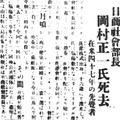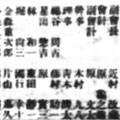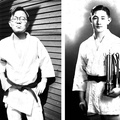COMPLAINTS AGAINST JAPANESE HOTEL BUSINESSES
In the midst of such developments, the North American Times published quite a few articles on people complaining about the high prices of hotel rooms and the excessive buying and selling of hotels. At the same time, it published ones praising the development of hotel businesses.
“Domination of Japanese Hotels Could Be Root of Future Trouble” (Oct. 16, 1918 issue)
 “Domination of Japanese Hotels Could Be Root of Future Trouble,” (North American Times, Oct. 16, 1918)
“Domination of Japanese Hotels Could Be Root of Future Trouble,” (North American Times, Oct. 16, 1918)“There are about 250 hotels that are owned by Japanese. From the waterfront to Seventh Avenue, you can find 100-plus hotels, all of which are run by Japanese. We can probably say that most of the major hotels in south Seattle that mainly serve workers are operated by the Japanese. Their customers are mostly Caucasian workers, specifically those working in shipbuilding yards.
“We have warned our readers many times in our paper that Caucasian customers are feeling antipathy toward Japanese hotels and making complaints, due to hotel businesses being inhospitable. The recent increase in hotel charges seems to continue nonstop, with no set ceiling. It’s such a loathsome thing to say that ‘those who can’t afford it should not use it.’ Sales people should explain that ‘the increase in hotel charges happens only naturally because the labor fee in the hotel business has gone up and the laundry fee has gone up. But the way the hotel charges are increasing these days is incomparable to how the cost of materials is rising.
“Today, the owners are charging a dollar or a dollar and half for a room that’s usually worth around 50 cents. In a more extreme scenario, they would take unfair advantage of their customers and charge two dollars for a room, which is outrageous. With more people buying and selling hotels these days... they have paid an unthinkable amount (100 dollars per room) for their property, which consequently forces them to increase the hotel charge absurdly – this serves as an irritation to customers.”
In an article titled “Future of Japanese Hotel Businesses in Seattle” (Jan. 1, 2919), Eihan Okiyama commented on this complaint:
“We can’t deny the negative aspects of its growth. First, because the price of hotels has skyrocketed from two years ago, many people saw opportunities for speculative activities, which led them to buy and sell hotels frequently, making property owners worry about the potential risk. Second, hotels took unfair advantage of customers in the economic boom by charging them outrageous rates and made them lose faith in their business. Third, the owners somehow forgot their role of providing a service and treated their customers without sincerity or generosity.
“The first two aspectswere common characteristics of new hotel owners who had no choice but to raise the charges because they purchased the hotel at an exorbitantly high price. The third aspect could be seen in both newcomers and veterans, so I hope that owners reflect on how they have operated their businesses, prioritize their duty to serve customers with hospitality and sincerity, and treat Caucasian workers accordingly.
“The effect of hotel businesses providing positive experiences for customers will not be limited to softening the anti-Japanese feelings of Seattle residents. I believe that the effect will be much greater, considering that visitors from different states will spread (news of) the service through word of mouth across the country. I sincerely hope that for the well-being of the Japanese and for the future of their hotel businesses in Seattle, they will strive for serious consideration and for truthfulness.”
According to the Jan. 1, 1920 issue, Okiyama was not only a leading figure in the hotel industry, but was a 33-year-old with a bright future who founded Okiyama Shokai (Okiyama Trading Co.) and ran the trading business as well. He also served as chairperson of Nihonjin-kai (the Japanese Association) for two terms successively after 1934. He attended my grandfather Yoemon’s funeral in 1928 as a representative of his friends.
Japanese Hotels in 1939 and 1940
“Board Members of the Hotel Union This Year” (Jan. 18, 1939 issue)
“The Seattle Japanese Hotel Union held its general meeting at Maneki restaurant. With 120 members in attendance, the following people were chosen as board members this year: Tokihiro Hayano as union president, Kumataro Matsuda and Kazukichi Tsujimoto as vice presidents, Seiichi Hara as senior director, Hisato Fujii as director, Kaizo Chikamura and Shosuke Yamamoto as chairpersons, Eihan Okiyama and Mannosuke Shiraishi as advisors. As of now, 207 hotels have joined the Union.”
In an article titled “Hotel Union Elects Its Board Members” (Jan. 13, 1940), Kazukichi Tsujimoto was elected union president and Tokihiro Hayano, who had been a chairperson, became an advisor. There were 129 people in attendance and the Union had 213 members.
Sumiyoshi Arima, president of the North American Times, using his Ichiro Hanazono pseudonym, proposed the idea of bringing Seattle’s successful Japanese hotel businesses to Japan in his column series, “Hokubei Shunjyu (North American Spring and Autumn)”
“Hokubei Shunjyu—Is It Not Possible for You Hotel Workers to Branch Out into Japan?” (Jan. 18, 1939 issue)
“We see more hotels built in Tokyo these days but it’s still hard to find ones that are easily affordable, make the guests feel comfortable, and are relatively economical at the same time... You hardly see any hotels in Osaka and Kobe... this has got me thinking. Why don’t you, my peers who have plenty of experience in the business and have made a success here, start a hotel company and run an American-style hotel business in Japan? Wouldn’t the American-style be the best in the hotel business? Plus, it would seem rather natural for hotel workers in the U.S. who have experience in the American-style business to make the leap and operate American-style hotels in Japan. Also, luring American tourists to Japan and giving them feelings of satisfaction and entertainment might be one of the best things that a hotel worker in the U.S. could do.”
This passage shows how advanced Japanese hotels in Seattle were from the perspective of someone in Japan.
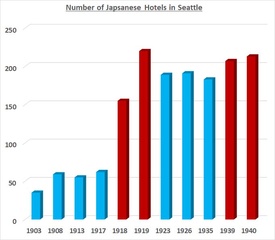
Looking at the articles I have introduced so far, we can clearly see the development of Japanese-owned hotel businesses in Seattle. In 1918, there were about 140 hotels run by Japanese. The number jumped to over 200 in 1919, which shows just how dramatic the growth was.
The momentum carried through for years, with 207 Japanese-owned hotels operating in 1939 and 213 in 1940. Most of the hotels south of Yesler Way were owned by Japanese. When we look at the map of Hokubei Hyakunen Zakura (the original 1969 Japanese version of Kazuo Ito’s Issei, A History of Japanese Immigrants in North America, 1973), we can see 33 Japanese-owned hotels south of Yesler Way. Among them are Manpei Miyagawa’s “Puget Sound Hotel,” Chojiro Nagai’s “Fujii Ryokan” (inn), and “Panama Hotel,” which still exists today as a national historic landmark.
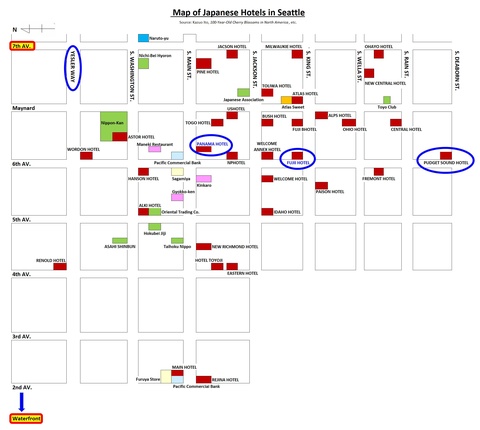
My grandfather Yoemon operated a hotel business himself in 1928, after making a success of the barbershop business. By reading articles from the North American Times, I was more convinced as to why running a hotel was such an attractive business for Yoemon.
In the next chapter, I will introduce some Japanese newspapers that helped the lives of Nikkei people.
References:
Junichi Torai, Hokubei nihonjin soran (Compendium of the Japanese in North America), Chuo Shobo, 1914.
Hokubei nenkan (North American Yearbook), Hokubei Jijisha, 1913.
Kazuo Ito, Hokubei hyakunen zakura (100-Year Cherry Blossoms in North America), Nichibou Shuppan, 1969.
*The English version of this series is a collaboration between Discover Nikkei and The North American Post, Seattle’s bilingual community newspaper. This article was originally publishd on August 29, 2022 in The North American Post.
© 2022 Ikuo Shinmasu




